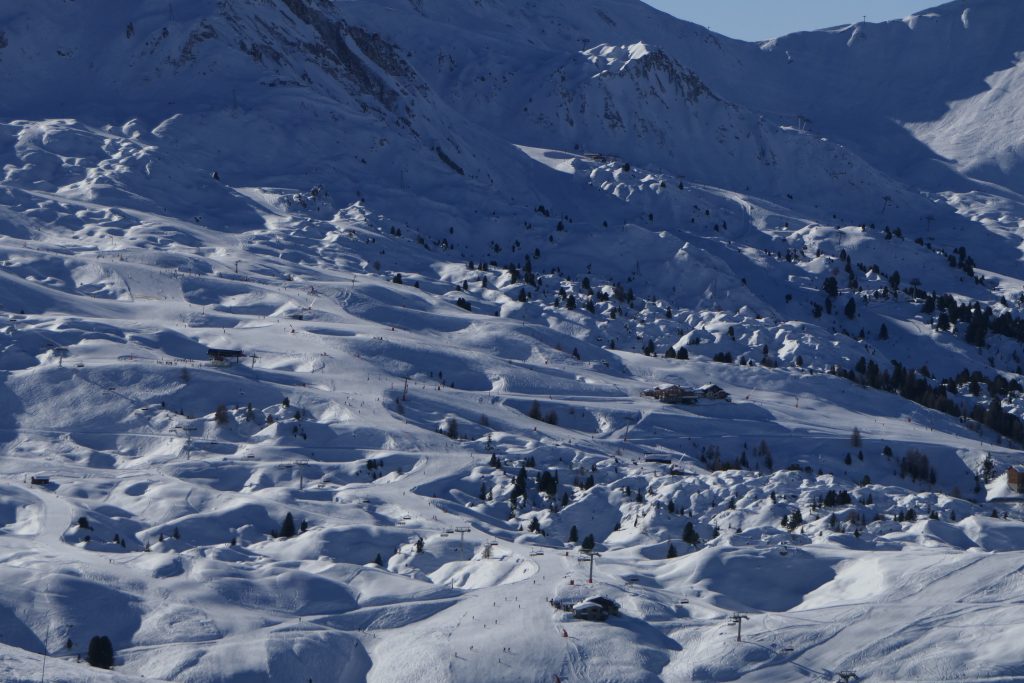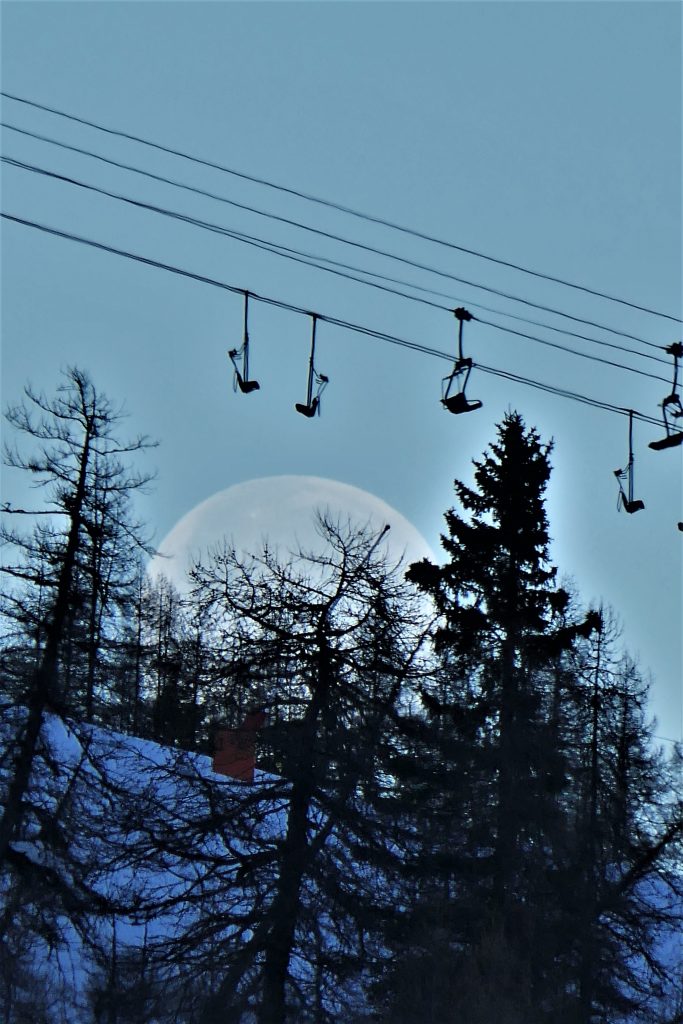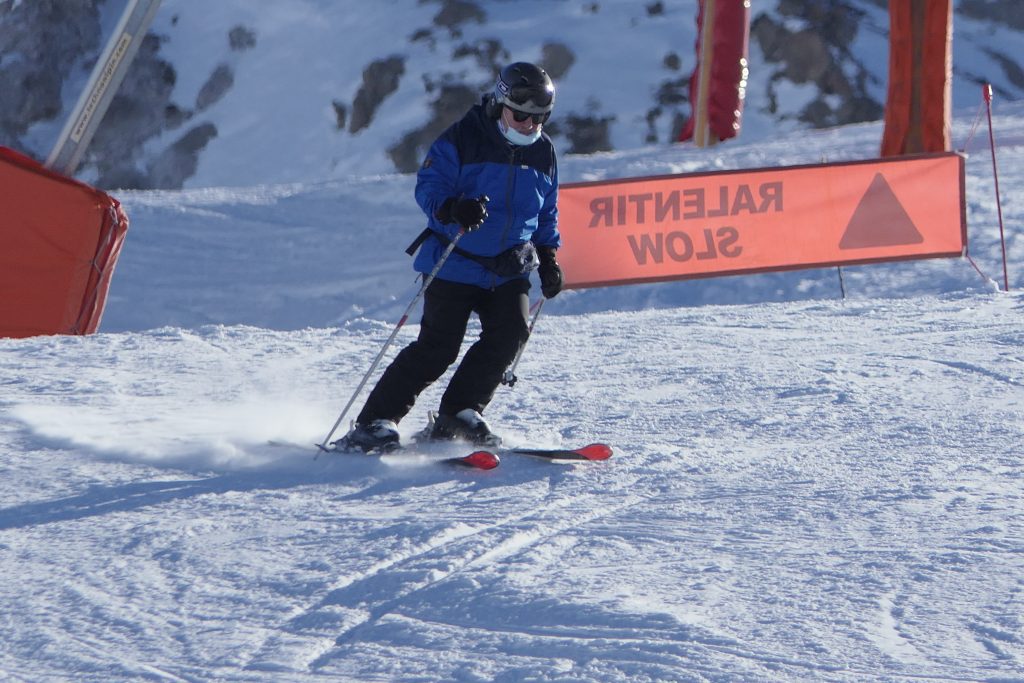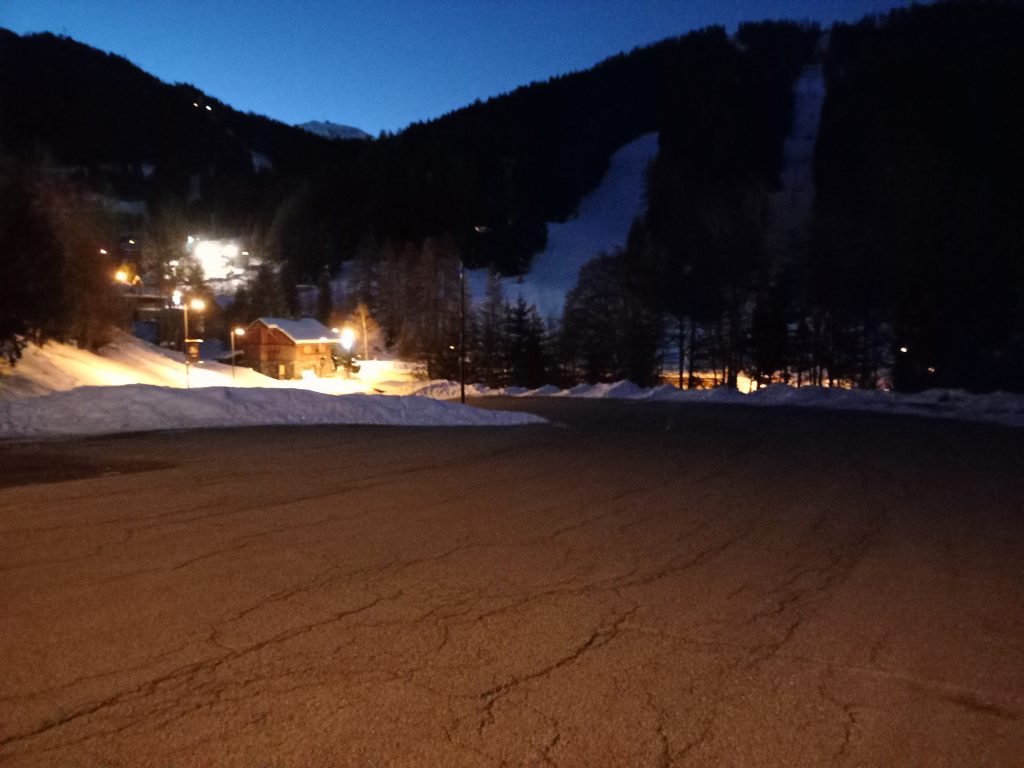Both Julia and Mick felt immediate improvement today during their run down the hill to our meeting point. That was the anticipated outcome of correcting the ski boot alignment (in the context of working on dynamics) and it was also confirmation that the adjustments were correct and appropriate.
Today’s session began with some skiing just to become accustomed to the radically altered boot alignment. The ski boot cuffs hold the skis on edge during lateral movements of the centre of mass and during manifold changes of shapes made by the feet. (…at least when the feet are not encumbered by orthopaedic insoles. It’s better to learn how to use the feet properly rather than rely on medical devices or their equivalent but that’s an issue to be addressed some time in the future.)
SKATING/TIMING
Returning to the skating there was a visible difference in edge grip all round so we were able to experiment with a wider stance (placing the skis even more on edge) bringing the tails together (Mick) and feeling the role of gravity in the skating action.
The very end of the session also involved skating but as the main basis for “down/up” timing in skiing. Just like you come down when falling in the skate (or walk/run) then push back up from that same support leg to finish, skiing does the same thing in an arc. Mick does this instinctively. Julia doesn’t so due to past teaching she tends to brace against the forces towards the end of the turns and stiffen the support leg.
Until this point I’d only previously mentioned pushing with the uphill leg to drive the centre of mass downhill. This was an essential starting point to simplify dynamics. Now I was asking for the completion of the turn on the downhill leg to be made by pushing up as the body was crossing over the skis coming out of the turn. There’s many ways that pressure can be modulated with the legs but the two separate exercises are only aimed at providing basic building blocks – 1) active use of the legs from skating timing (instead of passive bracing/resistance). 2) Active dynamics from the uphill leg at the turn initiation (instead of transferring weight towards the exterior of the turn).
Either do a push at the start or a push at the end – same leg. The CoM still makes the same down /up pressure cycle.
The skating exercise used involved skating directly down the fall-line with skis diverging. Then dynamics was introduced falling laterally to the inside of each stride so that the skis would start to make arcs – converting the skate into turns with the skis coming parallel automatically- but with the legs still skating!

POLE TOUCH
“Pole touch” was explained to help reinforce the dynamics. The “touch” is when the skier comes up out of the turn and the body is momentarily perpendicular to the slope – travelling across the slope. The touch provides sensory feedback of the whereabouts downhill of the snow and body as the new turn begins.
“Pole plant” is only used when “pivoting” – which we looked at later on.
ANGULATION
After getting used to the new boot alignment and reinforcing the dynamics we moved on to developing angulation – that is enabling hip joint and lower back to play an active role safely in modulating the CoM movement. In standard teaching this is simply “Face Downhill” and a veritable disaster for both the skiing and lower back health.
All that is required is that the hip on the supporting leg – from start to end of the turn – is pulled backwards in a slight counter-rotation to the turn itself. Basically the pelvis ends up facing downhill towards the end of the turn – not the shoulders . This activates the core muscles and protects the back. For more detail see the following: http://madeinmountains.com/chiskiing/
This helped Julia reduce her tendency to rotate her upper body during the turns. There remains some rotation as there’s still a tendency to reach forward with the outside arm and bend at the hips too much – partly due to previous inappropriate “pole plant” use – but we will look more closely at this towards the end of this blog entry.

WORKING THE SKI – TIGHT DYNAMIC TURNS ON THE STEEP
When sliding forward and using dynamics there are specific ways of tightening a turn to cope with steep slopes. Pushing the outside ski forward makes the ski cut under the CoM more actively and tightens the turn. We used a static exercise with skis off to develop the feel. At no point does the foot get pushed “ahead” with the skier falling onto the back of the boot – the skier can remain on the front of the boot all the time. The sensation generated is “working the ski”. The steep slope may require strongly committed dynamics so the active working of the ski gets it back beneath (downhill of) the skier rapidly and controls speed with no direct braking effect – it’s the tight turn radius controlling the speed.

PIVOTING – BREAKING TURNS ON THE STEEP
Pivoting is how we make a turn directly from a sideslip (No forward motion) – with very restricted dynamics – the CoM motion being controlled by a strong supportive pole plant. This is the ultimate way to turn with full snow contact on the steep giving maximum control over speed and safety directly in the fall line. Both skiers were manually assisted initially in order to experience and identify the required feeling. Initial attempts were encouragingly successful and are on the accompanying video clip above. For a full breakdown and demos of pivoting see here: http://madeinmountains.com/pivo/
One modification of the pivoting teaching that should be mentioned is that I now don’t believe it is good to use the “inside edge” of a pronated foot. The foot should permanently be supporting the body on its outside edge, the ball and the heel. This appears to provide maximum protection to the knee and hip joints whilst not interfering with other aspects of ski technique.
Most skiing is Actually a blend of dynamics and Pivoting – but nearly everybody is unconscious of the elements. (We have not looked at genuine “carving”yet – which is where all pivoting is completely eliminated)

FORE/AFT PRESSURE
Mick’s overall stance on his skis is actually pretty good. Julia’s stance needs some work – but nothing that can’t be handled. The issues appear to be due to the pelvis being dropped at the front – a hollowed lower back bringing the elbows inwards, causing over bending at the hips as the body tilts forwards and a pressure on the backs of the skis boots. ALL of this can actually (possibly) stem from trying to bend at the ankles – and that can stem from using the wrong vertical timing – which is why we did the skating work at the end of the session. It can all be sorted out. Dynamics and Skating will contribute to the sorting out. Most people (nearly all of them ) don’t realise how much pressure the front of a ski really needs at least at the start of the turn – and that it’s the whole body tilting forward hard against the shaft of the ski boot and with a STRONG ankle – not a flexed ankle. It’s vital to combine forward pressure on the ski fronts with angulation as that guarantees safety and no “faceplants” – even in deep snow!


